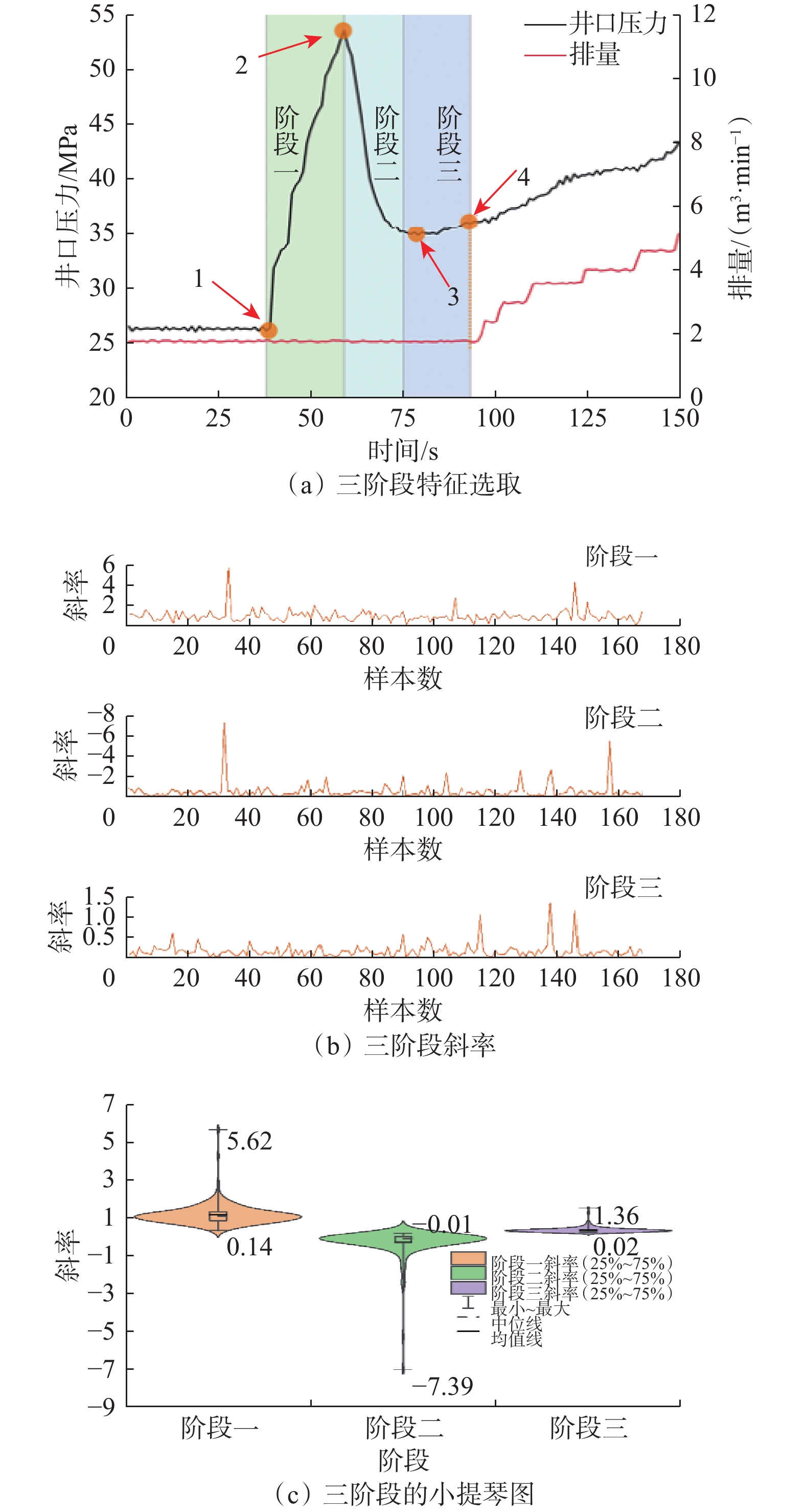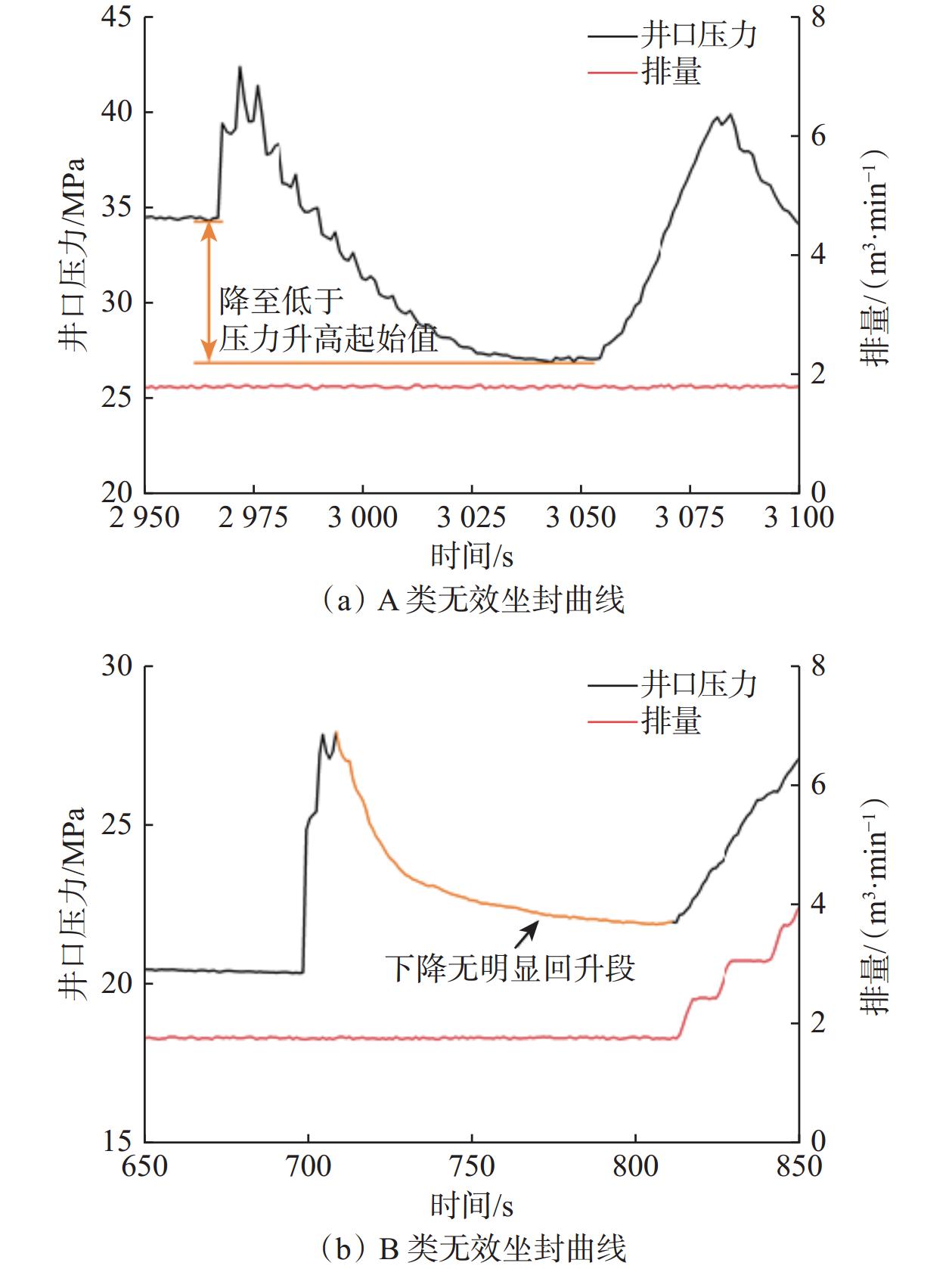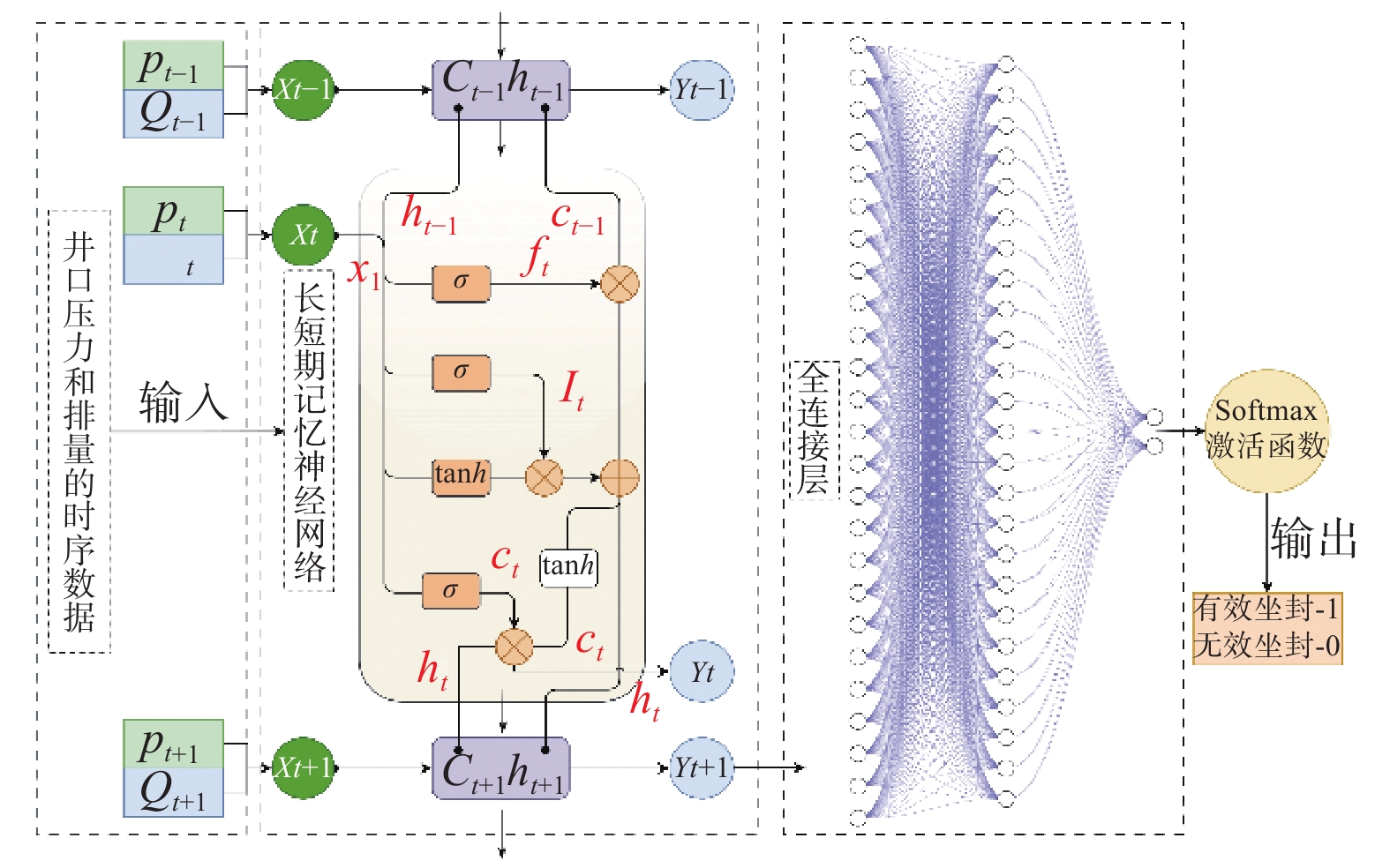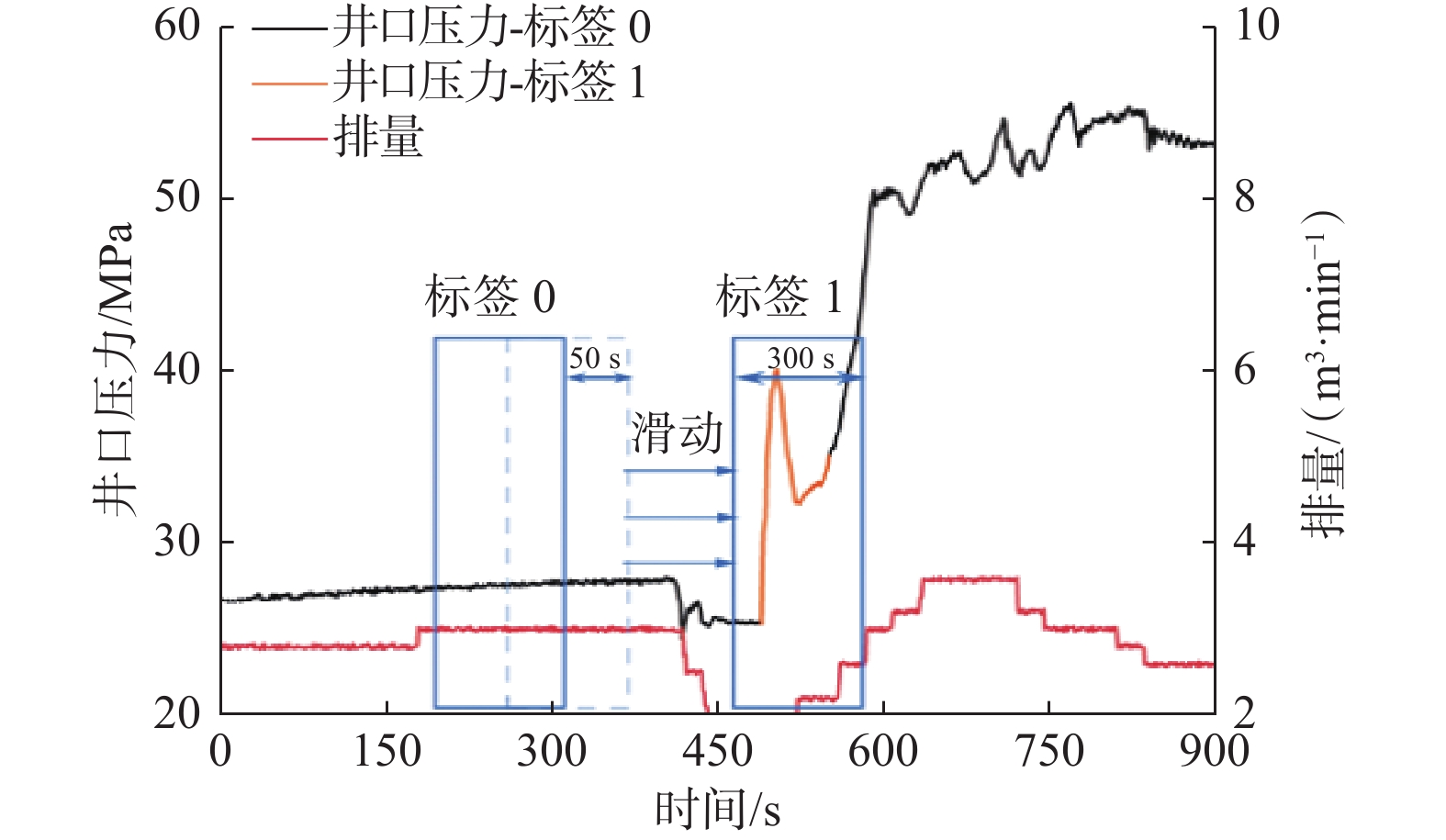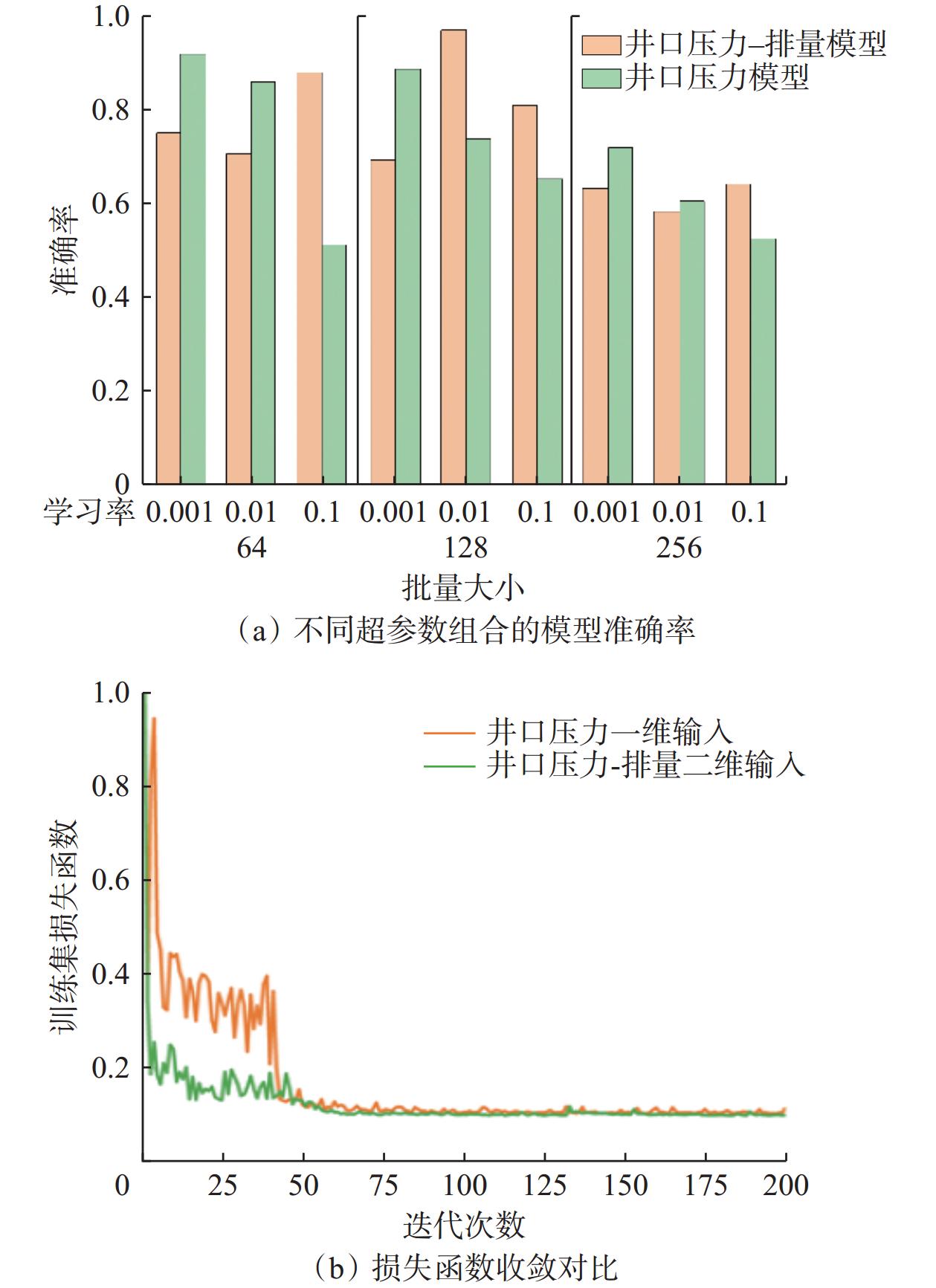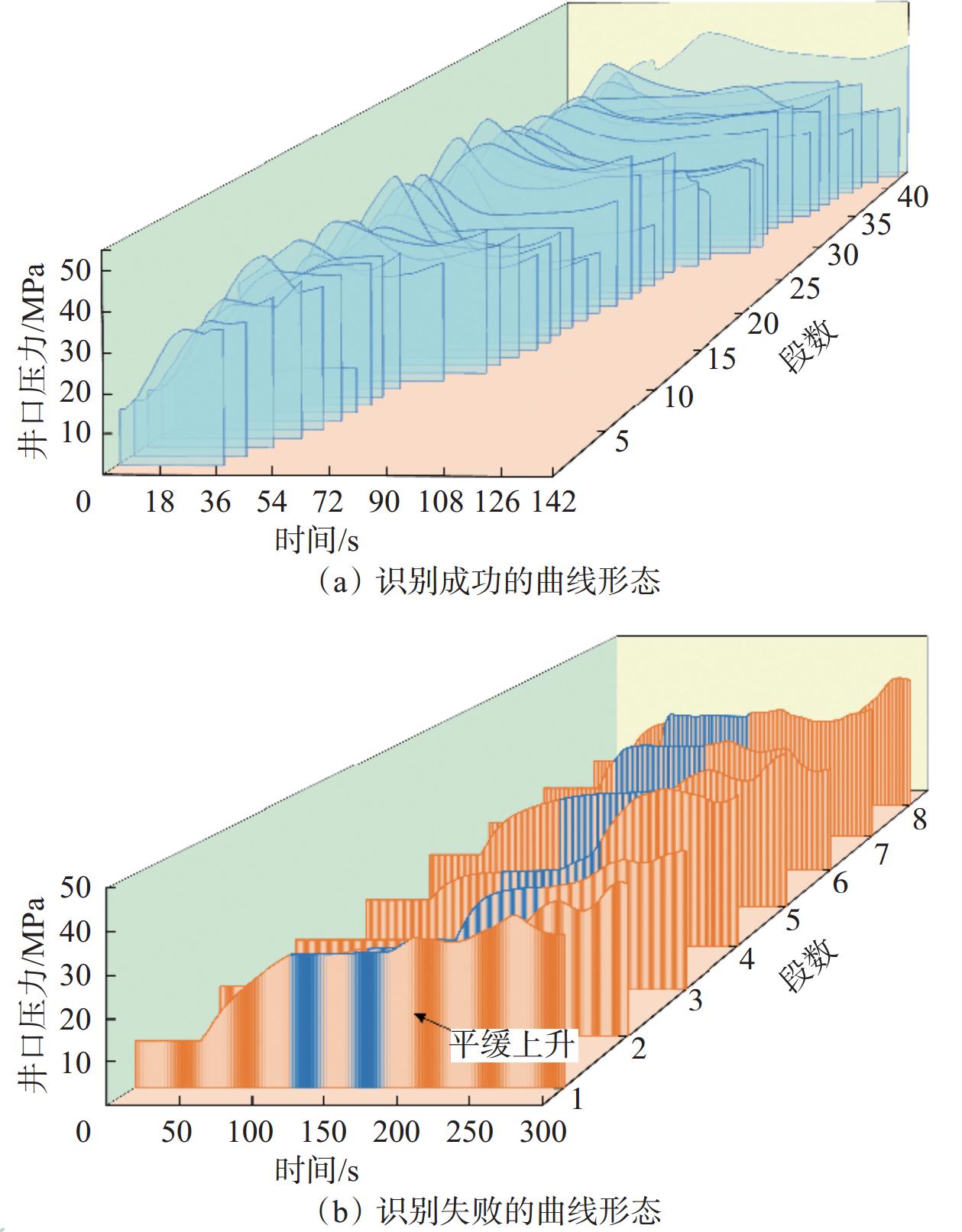Intelligent Diagnosis for Effectiveness of Data-Knowledge Mixed-Driven Fracturing Ball Seat Setting
-
摘要:
水平井桥塞分段压裂时的桥塞球座坐封有效性实时诊断是其关键环节,若球座坐封失效,将无法正常进行后续作业,目前主要依靠人工观察井口压力变化特征,难以快速准确判识。为此,融合专家经验定性判识和坐封数据特征挖掘定量标注,滑动窗口数据切片形成
5792 组标签数据,优选井口压力–排量二维输入的长短期记忆神经网络,建立了压裂球座坐封有效性智能诊断模型,并采用欠采样平衡数据集方式提升模型预测精度。结果表明,井口压力呈现显著的陡升—陡降—平缓上升的三阶段特征,若井口压力缺失某个阶段特征,则为坐封失效;井口压力斜率统计值分布范围较大,无法形成明确规则实现准确诊断。采用人工智能技术学习不同井口压力形态的有效/无效坐封数据特征,实现了每秒输出诊断结果,测试集准确率96.8%,验证集准确率84.3%。研究结果为桥塞球座坐封有效性实时自动诊断提供了方法。Abstract:Real-time diagnosis of the effectiveness of the bridge plug ball seat setting is a key step in the staged fracturing of horizontal wells. If the ball seat setting fails, follow-up operations cannot proceed normally. Currently, manual observation of wellhead pressure changes is primarily relied upon, making it difficult to quickly and accurately identify key characteristics. To address this, a combination of expert qualitative judgment and quantitative feature mining of setting data was implemented. Sliding window data was segmented to form
5792 sets of labeled data. A long short-term memory (LSTM) neural network, using a two-dimensional input of wellhead pressure and displacement, was selected. An intelligent diagnosis model for evaluating the effectiveness of the fracturing ball seat setting was established, utilizing an under-sampling balanced dataset to improve the model’s prediction accuracy. The results show that the setting data exhibits a clear three-stage characteristic: a steep rise, a steep drop, and a gentle rise in wellhead pressure. If the wellhead pressure lacks any of these stage characteristics, it indicates an invalid setting. The wellhead pressure slope exhibits a wide distribution range, making it difficult to form explicit rules for accurate diagnosis. Artificial intelligence technology is used to learn the valid/invalid setting data characteristics from various wellhead pressure forms, producing diagnosis results per second with an accuracy of 96.8% for the test set and 84.3% for the validation set. The findings are expected to provide a method for real-time and automatic diagnosis of the effectiveness of the bridge plug ball seat setting.-
Keywords:
- hydraulic fracturing /
- ball seat setting /
- intelligent diagnostics /
- data mining /
- deep learning
-
水平井桥塞分段压裂已成为非常规油气高效开发的核心技术之一[1]。桥塞用于封隔已压裂井段裂缝,通常桥塞中心管中空,需井口投球、落入桥塞球座,起到密封桥塞中心管的作用。当桥塞球座处于完全密封状态,则为有效坐封[2]。一旦球座坐封失效,易发生压裂砂堵、重复压裂已改造井段等问题,无法正常后续作业。目前主要依靠人为观察井口压力变化特征判断坐封的有效性,然而对于非典型压力特征,难以快速准确识别,这已成为制约水平井桥塞分段压裂技术发展的瓶颈之一。
近年来,以大数据、机器学习、超强算力为基础的新一代人工智能技术蓬勃发展[3–4],基于海量压裂历史数据,通过人工智能算法从大数据中学习数据变化特征[5–7],形成了压裂工况智能诊断方法,达到实时诊断压裂工况的目的。前人已开展基于大数据分析的压裂起止时刻、暂堵、球座坐封等工况诊断研究。A. Ramirez等人[8]采用分类算法结合泵压曲线和专家经验,实现压裂作业起始与终止时刻的识别;M. M. Awad等人[9]利用小波变换方法将施工泵压蕴含的能量信息与裂缝扩展物理过程相关联,实现了单位时间内裂缝扩展事件数的定量表征;袁彬等人[10]结合长短期记忆神经网络、反向传播神经网络等多种模型,实现了泵球、前置酸降压、暂堵压裂、砂堵等事件的智能识别;盛茂等人[11]利用聚类算法、特征参数阈值法分析压裂施工数据,建立了暂堵有效性评价模型。Shen Yuchang等人[12]利用包含地面泵压以及排量的施工曲线图,基于识别图像的U-Net架构深度学习算法,建立了桥塞球座坐封起止时刻的识别模型,识别准确率达95%。该研究的判别特征是单一的排量下降,而复杂地层压裂作业过程中往往存在大量的排量下降现象,但这些并不都是由桥塞球座坐封造成的,因此仅以排量下降作为识别坐封工况的特征具有一定局限性。
为此,笔者融合专家经验定性判识和坐封数据特征挖掘定量标注,滑动窗口数据切片形成5 792组样本数据,优选井口压力–排量二维输入的长短期记忆神经网络,建立了压裂球座坐封有效性智能诊断模型;并采用欠采样平衡数据集方式提升模型判识精度,实现了每秒输出诊断结果,为桥塞球座坐封有效性实时自动诊断提供了方法。
1. 球座坐封特征参数提取
1.1 压裂球座坐封工况数据分割与标签标注
水平井桥塞分段压裂时,压裂投球坐封阶段,排量先降至0.5~1.0 m3/min,维持压裂球以较低速度坐入桥塞球座;当球座被完全密封,井筒内流体憋压,此时井口压力显著升高[13];压力达到地层破裂压力使地层破裂后,井口压力骤降;随后逐级提高排量至压裂设计值,井口压力缓慢上升,整个投球坐封阶段井口压力呈现陡升—陡降—平缓上升的显著特征(见图1)。根据该特征,采用滑动窗口方式,对球座坐封工况进行数据分割:在排量开始降低且累计排量小于井筒体积的时段寻找第一次压力突升的时刻,并标记为坐封开始时刻;在滑动时间窗口寻找压力降落结束时刻,向后继续寻找至排量开始增加的时刻,并标记为坐封结束时刻。
工况分割后形成198段坐封数据,结合专家经验对井口压力和排量的变化特征进行判识,对每段坐封数据打标签,分为有效坐封和无效坐封2类标签,分别将其对应的时刻标记为数字1和0,最终得到有效坐封168段,无效坐封30段。
1.2 有效坐封数据特征分析
整合并提取168段有效坐封数据共有的特征点,分别是压力升高前的最小值、压力升高后达到的峰值、压力下降后的最小值及排量开始增加时刻的压力回升值,形成1—2,2—3,3—4明显的三阶段特征(见图2(a));统计3个阶段对应的持续时间及井口压力变化值,得到各阶段的斜率分布和小提琴图(见图2(b)和(c))。
从图2可知,阶段一压力上升变化斜率区间[0.14,5.62];阶段二压力下降变化斜率区间 [−0.01,−7.39],分布范围较大;阶段三压力上升变化斜率区间[0.02,1.36],与前2个阶段相比,分布区间更为集中。尽管有效坐封数据均呈显著的井口压力陡升—陡降—平缓上升的三阶段特征,但是数据样本分布范围较大、且不一致,无法形成明确的诊断规则实现准确诊断。
1.3 无效坐封数据特征分析
统计分析30段无效坐封数据,发现存在2类形态的无效坐封曲线(见图3)。其中,A类无效坐封虽然存在阶段一对应的压力升高过程,但阶段二的压力会降至低于压力升高前的起始值;B类无效坐封的井口压力在降低后直至提排量前始终未呈现回升趋势。
2. 基于长短期记忆神经网络模型建立
2.1 神经网络结构设计
压裂泵注曲线具有显著的长时序性和数据关联性,即压裂全过程具有较长的时间跨度,且每个时间步长之间的压力存在依赖关系,为此优选长短期记忆神经网络[14–18],其特有的记忆门控单元可捕捉序列数据中的长期依赖关系[19–20]。神经网络设计采用二分类问题的设计思路,其中隐含层初始设置为256层,输入维度分别设置为一维和二维,输出设置为代表坐封有效与失效的1或0标签,对每一种输入特征值进行批标准化处理;选择Softmax激活函数对每一维度相同位置的数值进行Softmax运算,每次模型调用时对待训练参数矩阵和待训练偏置项进行初始化处理;选用Adam优化器处理二分类问题,初始学习率设置为0.01;使用交叉熵损失函数表征模型输出的有效坐封标签与实际有效坐封标签的偏差,来衡量该网络在此数据集上对坐封有效性识别效果的好坏。每次输入神经网络的训练集样本数初始设置为128个,迭代200次,每次迭代输出一次损失函数,保留最后一次训练参数,并计算准确率。神经网络结构如图4所示。
图4中,t表示时间,p和Q分别表示井口压力与排量的时序值,X和Y表示LSTM网络的输入和输出,σ和tanh分别表示sigmoid激活函数和tanh激活函数,参数C、h、f、i和o分别代表LSTM网络的细胞状态、隐藏状态、遗忘门、输入门和输出门。
2.2 标签数据切片处理
全连接层的神经元网络用分割出的坐封段作为训练数据集时,训练集太过冗长,会大大增加迭代时间,影响训练效果[21],因此采用滑动窗口切片送入模型的方式来缩短训练的数据长度[22]。
统计每段数据中有效坐封的3个阶段特征的时长,得出坐封所需的时间最长为252 s。为保证特征被全部包含,将时间跨度增加,初步设定切片窗口为300 s。考虑到时间序列前后数据的相关性,设置移动步长为50 s,即窗口每次向后移动50 s,以保证对同样的一段坐封特征,其前后段的数据都能作为有效坐封的样本输入,同时也增加了样本数量。窗口从左到右,依次对每个时刻的标签进行扫描,当该窗口第一秒和最后一秒的标签均为0,且中间有且仅有一段连续为1的标签时,视为此窗口包含了一个完整的坐封段,并将整个窗口标记为标签1,作为一个有效坐封样本;当窗口内数据标签均为0,或者由1开始与结束,即无坐封段或坐封段不完整时,整个窗口标记为标签0,作为一个无效坐封样本。滑动窗口切片标注如图5所示。
198段坐封工况数据按照时间窗口300 s、移动步长50 s切片后形成5 792个样本,其中有效坐封383个,占比仅6.61%。当二分类模型中标签为1的数据量极少时,神经网络被重复传入大量的无效坐封样本,从而无法学习到有效坐封的特征。为此,采用欠采样平衡数据集方式[23],从切片后的样本中等比例地提取标签为1和0的样本,总计766个,再以8∶2的比例划分为训练集和测试集,最终形成610个样本的训练集,156个样本的测试集。
3. 模型训练与结果分析
为考察压力和排量变化对坐封有效性判识效果的影响,分别建立井口压力一维输入和井口压力–排量二维输入的长短期记忆神经网络模型进行对比训练。首先,调整数据切片时间窗口为300,400和500 s,随着时间窗口增长,准确率由88%降至70%,表明过长的时间窗口导致样本包含更多冗余的数据信息,从而输入的干扰特征增多,因此时间窗口选择300 s;然后,调整批量大小为64,128和256,学习率分别为0.001,0.01和0.1,进行组合训练,训练结果如图6(a)所示。训练结果表明,批量大小为256时,模型准确率整体偏低,仅为50%~70%;批量大小为64、学习率为0.001时,井口压力一维输入模型的准确率最高为91.7%;批量大小为128、学习率为0.01时,井口压力–排量二维输入模型的准确率最高为96.8%,相比井口压力一维输入模型提高5.1百分点。2种模型准确率最高时对应的损失函数变化曲线如图6(b)所示。由图6(b)可以看出,迭代至第25次时,井口压力一维输入模型的损失函数降至0.30,而井口压力–排量二维输入模型的损失函数降至0.15,收敛速度更快,最终趋近于0.10。
验证集选用长庆油田合水区块51段未参与训练的压裂数据。将井口压力和排量数据以时间窗口300 s、移动步长1 s滑动输入模型,模型调用训练准确率最高的权重参数进行判识,实时输出坐封工况判识标签。若井口压力从排量降至送球排量时开始运行到累计液量达到一个井筒体积时仍未呈现三阶段特征,则判识为无效坐封。对比专家经验标签,井口压力一维输入的模型准确率为73.7%,井口压力–排量二维输入的模型准确率为84.3%。将模型识别出的43段有效坐封段绘制成瀑布图(见图7(a)),可以看出,虽然井口压力数据跨度分布较大,但该模型均能正确判识,验证了模型的有效性;将实际有效坐封、但模型误判为无效坐封的8段数据绘制成瀑布图(见图7(b)),发现此类曲线在压力突升至峰值后有一段时间的缓慢爬升,未能被该模型识别,其原因是此类情况下输入样本不足,长短期记忆神经网络未能学习到该类曲线的特征。
4. 结 论
1)针对压裂桥塞球座坐封有效性难以形成有效规则、快速准确判识的问题,提出了人工智能技术辅助诊断方法。融合专家经验定性判识和坐封数据特征挖掘定量标注,建立了基于长短记忆神经网络的压裂球座坐封有效性智能诊断模型,并采用欠采样平衡数据集方式提高模型的预测精度。
2)压裂桥塞球座有效坐封时,井口压力呈现陡升—陡降—平缓上升特征,但各阶段变化值分布离散,持续时间跨度大;无效坐封时,井口压力呈2种形态,一种是陡降幅度超过陡升幅度,一种是缺少平缓上升阶段特征。
3)利用未参与训练的51个样本验证模型,井口压力–排量二维输入模型成功识别出43个有效坐封段,准确率达84.3%。
-
-
[1] 刘合. 石油勘探开发人工智能应用的展望[J]. 智能系统学报,2021,16(6):985. LIU He. Prospect of artificial intelligence application in petroleum exploration and development[J]. CAAI Transactions on Intelligent Systems, 2021, 16(6): 985.
[2] 郭鸣,詹鸿运,冯强,等. 高强度可溶桥塞结构设计与应用[J]. 石油钻采工艺,2020,42(1):52–55. GUO Ming, ZHAN Hongyun, FENG Qiang, et al. Design and application of high-strength dissolvable bridge plug[J]. Oil Drilling & Production Technology, 2020, 42(1): 52–55.
[3] 肖立志. 机器学习数据驱动与机理模型融合及可解释性问题[J]. 石油物探,2022,61(2):205–212. XIAO Lizhi. The fusion of data-driven machine learning with mechanism models and interpretability issues[J]. Geophysical Prospecting for Petroleum, 2022, 61(2): 205–212.
[4] 杨剑锋,杜金虎,杨勇,等. 油气行业数字化转型研究与实践[J]. 石油学报,2021,42(2):248–258. YANG Jianfeng, DU Jinhu, YANG Yong, et al. Research and practice on digital transformation of the oil and gas industry[J]. Acta Petrolei Sinica, 2021, 42(2): 248–258.
[5] 匡立春,刘合,任义丽,等. 人工智能在石油勘探开发领域的应用现状与发展趋势[J]. 石油勘探与开发,2021,48(1):1–11. doi: 10.1016/S1876-3804(21)60001-0 KUANG Lichun, LIU He, REN Yili, et al. Application and development trend of artificial intelligence in petroleum exploration and development[J]. Petroleum Exploration and Development, 2021, 48(1): 1–11. doi: 10.1016/S1876-3804(21)60001-0
[6] 李根生,宋先知,祝兆鹏,等. 智能钻完井技术研究进展与前景展望[J]. 石油钻探技术,2023,51(4):35–47. LI Gensheng, SONG Xianzhi, ZHU Zhaopeng, et al. Research progress and the prospect of intelligent drilling and completion technologies[J]. Petroleum Drilling Techniques, 2023, 51(4): 35–47.
[7] 曾凡辉,胡大淦,张宇,等. 数据驱动的页岩油水平井压裂施工参数智能优化研究[J]. 石油钻探技术,2023,51(5):78–87. ZENG Fanhui, HU Dagan, ZHANG Yu, et al. Research on data-driven intelligent optimization of fracturing treatment parameters for shale oil horizontal wells[J]. Petroleum Drilling Techniques, 2023, 51(5): 78–87.
[8] RAMIREZ A, IRIARTE J. Event recognition on time series frac data using machine learning[R]. SPE 195317, 2019.
[9] AWAD M M, ELTALEB I, MANSI M, et al. Interpretation of hydraulic fracturing events by analyzing the energy of rate and pressure signals[R]. SPE 201328, 2020.
[10] 袁彬,赵明泽,孟思炜,等. 水平井压裂多类型复杂事件智能识别与预警方法[J]. 石油勘探与开发,2023,50(6):1298–1306. YUAN Bin, ZHAO Mingze, MENG Siwei, et al. Intelligent identification and real-time warning method of diverse complex events in horizontal well fracturing[J]. Petroleum Exploration and Development, 2023, 50(6): 1298–1306.
[11] 盛茂,张家麟,张彦军,等. 基于数据驱动的水平井暂堵压裂有效性评价新模型[J]. 天然气工业,2023,43(9):132–140. SHENG Mao, ZHANG Jialin, ZHANG Yanjun, et al. A new data-driven effectiveness evaluation model of temporary plugging fracturing for horizontal wells[J]. Natural Gas Industry, 2023, 43(9): 132–140.
[12] SHEN Yuchang, CAO Dingzhou, RUDDY K, et al. Near real-time hydraulic fracturing event recognition using deep learning me-thods[J]. SPE Drilling & Completion, 2020, 35(3): 478–489.
[13] 董黎明,钟林,周忠泽,等. 全金属可溶球座密封环结构设计与性能分析[J]. 钻采工艺,2023,46(6):106–112. DONG Liming, ZHONG Lin, ZHOU Zhongze, et al. Structure design and performance analysis of all metal dissolvable ball seat seal rings[J]. Drilling & Production Technology, 2023, 46(6): 106–112.
[14] 罗发强,刘景涛,陈修平,等. 基于BP和LSTM神经网络的顺北油田5号断裂带地层孔隙压力智能预测方法[J]. 石油钻采工艺,2022,44(4):506–514. LUO Faqiang, LIU Jingtao, CHEN Xiuping, et al. Intelligent method for predicting formation pore pressure in No. 5 fault zone in Shunbei oilfield based on BP and LSTM neural network[J]. Oil Drilling & Production Technology, 2022, 44(4): 506–514.
[15] 康正明,秦浩杰,张意,等. 基于LSTM神经网络的随钻方位电磁波测井数据反演[J]. 石油钻探技术,2023,51(2):116–124. KANG Zhengming, QIN Haojie, ZHANG Yi, et al. Data inversion of azimuthal electromagnetic wave logging while drilling based on LSTM neural network[J]. Petroleum Drilling Techniques, 2023, 51(2): 116–124.
[16] 王俊,曹俊兴,刘哲哿,等. 基于长短期记忆网络的钻前测井曲线预测方法[J]. 成都理工大学学报(自然科学版),2020,47(2):227–236. WANG Jun, CAO Junxing, LIU Zhege, et al. Method of well logging prediction prior to well drilling based on long short-term memory recurrent neural network[J]. Journal of Chengdu University of Technology(Science & Technology Edition), 2020, 47(2): 227–236.
[17] 周济民,张海晨,王沫然. 基于物理经验模型约束的机器学习方法在页岩油产量预测中的应用[J]. 应用数学和力学,2021,42(9):881–890. ZHOU Jimin, ZHANG Haichen, WANG Moran. Machine learning with physical empirical model constraints for prediction of shale oil production[J]. Applied Mathematics and Mechanics, 2021, 42(9): 881–890.
[18] SUN J J, BATTULA A, HRUBY B, et al. Application of both physics-based and data-driven techniques for real-time screen-out prediction with high frequency data[R]. URTEC 2020-3349, 2020.
[19] SHI Xingjian, CHEN Zhourong, WANG Hao, et al. Convolutional LSTM network: a machine learning approach for precipitation nowcasting[C]//Proceedings of the 28th International Conference on Neural Information Processing Systems: Volume 1. Cambridge: MIT Press, 2015: 802-810.
[20] 祝启康,林伯韬,杨光,等. 低压低产页岩气井智能生产优化方法[J]. 石油勘探与开发,2022,49(4):770–777. doi: 10.1016/S1876-3804(22)60309-4 ZHU Qikang, LIN Botao, YANG Guang, et al. Intelligent production optimization method for a low pressure and low productivity shale gas well[J]. Petroleum Exploration and Development, 2022, 49(4): 770–777. doi: 10.1016/S1876-3804(22)60309-4
[21] YANG Dongchuan, LI Mingzhu, GUO Jue, et al. An attention-based multi-input LSTM with sliding window-based two-stage decomposition for wind speed forecasting[J]. Applied Energy, 2024, 375: 124057. doi: 10.1016/j.apenergy.2024.124057
[22] SHI Xin, HUANG Gaolu, HAO Xiaochen, et al. Sliding window and dual-channel CNN (SWDC-CNN): a novel method for synchronous prediction of coal and electricity consumption in cement calcination process[J]. Applied Soft Computing, 2022, 129: 109520. doi: 10.1016/j.asoc.2022.109520
[23] CHEN Zhuohang, CHEN Jinglong, FENG Yong, et al. Imbalance fault diagnosis under long-tailed distribution: challenges, solutions and prospects[J]. Knowledge-Based Systems, 2022, 258(C): 110008. doi: 10.1016/j.knosys.2022.110008



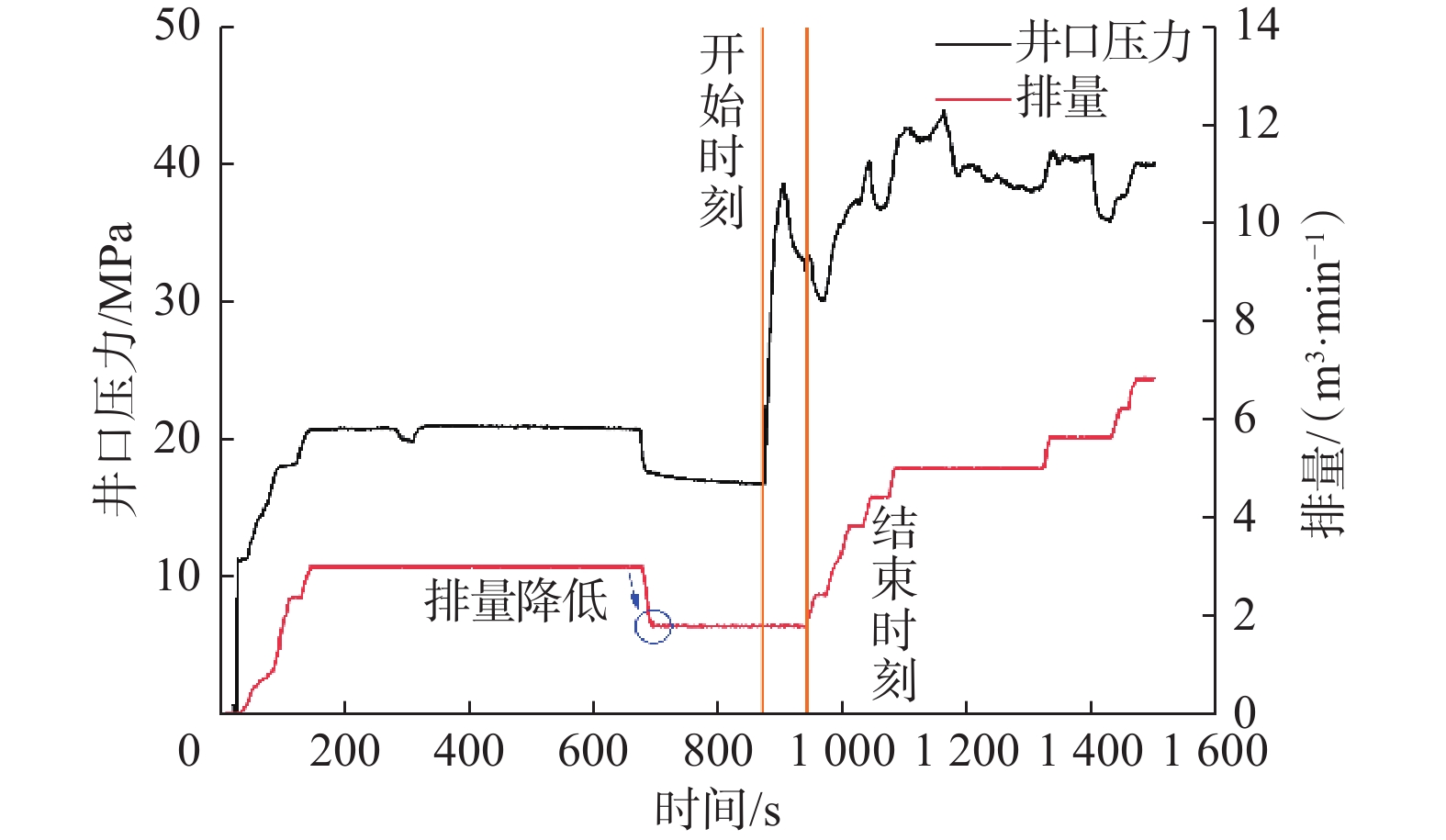
 下载:
下载:
